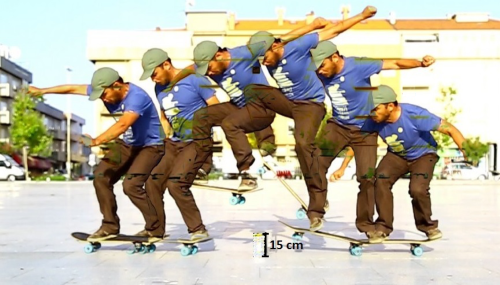
Free-body problem: how do skateboarders do an “ollie”? (Courtesy: Paulo Simeão Carvalho/Physics Education)
By Hamish Johnston
Here’s a problem for keen students of classical mechanics: how can a skateboarder cause their board to leap into the air by pressing down on it with their feet?
What I’ve described is a trick called the “ollie”, which first emerged on the skateboarding scene in the late 1970s and is now an essential part of the skating repertoire. There’s a fascinating paper in the journal Physics Education, which shows how digital videos of people doing an ollie can be analysed to get to grips with the physics underlying the trick.
The above image shows six video frames of someone executing an ollie – with time moving from right to left over a period of about 2 s. If you delve into the paper, you will find out how its authors – Marco Adriano Dias, Paulo Simeão Carvalho and Deise Miranda Vianna – used video images to track the motion of the tail of the board as well as its front and back wheels. This was then compared to a free-body diagram analysis of the forces of the board.
So what is the secret of doing an ollie? The crucial moment is when the tail of the skateboard strikes the ground resulting in a net upward force on the board. You can read more about the analysis and how it could be used to teach mechanics in “Using image modelling to teach Newton’s laws with the ollie trick”.
If you would like to see a demonstration of the ollie and hear a nice description of how to do the trick, watch the video below.
Trackback: Physics of … | Theo J. Mertzimekis, PhD
Yes skateboarding and physics. I teach physics using my skateboard and Bmx